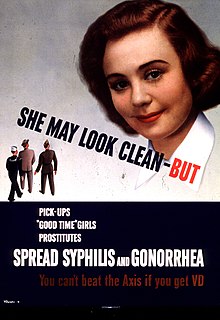History
The first well-recorded European outbreak of what is now known as syphilis occurred in 1494 when it broke out among French troops besieging Naples in the Italian War of 1494–98. The disease may have originated from the Columbian Exchange.[ From Naples, the disease swept across Europe, killing more than five million people. As Jared Diamond describes it, "[W]hen syphilis was first definitely recorded in Europe in 1495, its pustules often covered the body from the head to the knees, caused flesh to fall from people's faces, and led to death within a few months," rendering it far more fatal than it is today. Diamond concludes,"[B]y 1546, the disease had evolved into the disease with the symptoms so well known to us today.
Prior to the invention of modern medicines, sexually transmitted diseases were generally incurable, and treatment was limited to treating the symptoms of the disease. The first voluntary hospital for venereal diseases was founded in 1746 at London Lock Hospital. Treatment was not always voluntary: in the second half of the 19th century, the Contagious Diseases Acts were used to arrest suspected prostitutes. In 1924, a number of states concluded the Brussels Agreement, whereby states agreed to provide free or low-cost medical treatment at ports for merchant seamen with venereal diseases.
The first effective treatment for a sexually transmitted disease was salvarsan, a treatment for syphilis. With the discovery of antibiotics, a large number of sexually transmitted diseases became easily curable, and this, combined with effective public health campaigns against STDs, led to a public perception during the 1960s and 1970s that they have ceased to be a serious medical threat.
During this period, the importance of contact tracing in treating STIs was recognized. By tracing the sexual partners of infected individuals, testing them for infection, treating the infected and tracing their contacts in turn, STI clinics could effectively suppress infections in the general population.
In the 1980s, first genital herpes and then AIDS emerged into the public consciousness as sexually transmitted diseases that could not be cured by modern medicine. AIDS in particular has a long asymptomatic period—during which time HIV (the human immunodeficiency virus, which causes AIDS) can replicate and the disease can be transmitted to others—followed by a symptomatic period, which leads rapidly to death unless treated. HIV/AIDS entered the United States from Haiti in about 1969. Recognition that AIDS threatened a global pandemic led to public information campaigns and the development of treatments that allow AIDS to be managed by suppressing the replication of HIV for as long as possible. Contact tracing continues to be an important measure, even when diseases are incurable, as it helps to contain infection.
Cause
Transmission
The risks and transmission probabilities of sexually transmitted diseases are summarized by act in the table:
| Risk per unprotected sexual act with an infected person | |||
|---|---|---|---|
| Known risks | Possible | ||
| Performing oral sex on a man |
|
| |
| Performing oral sex on a woman |
|
| |
| Receiving oral sex—man |
|
| |
| Receiving oral sex—woman |
|
| |
| Vaginal sex—man |
|
| |
| Vaginal sex—woman |
|
| |
| Anal sex—insertive |
|
| |
| Anal sex—receptive |
|
| |
| Anilingus |
|
| |
Bacterial
- Chancroid (Haemophilus ducreyi)
- Chlamydia (Chlamydia trachomatis)
- Gonorrhea (Neisseria gonorrhoeae), colloquially known as "the clap"
- Granuloma inguinale or (Klebsiella granulomatis)
- Mycoplasma genitalium
- Mycoplasma hominis
- Syphilis (Treponema pallidum)
- Ureaplasma infection
Fungal
- Candidiasis (yeast infection)
Viral
- Viral hepatitis (Hepatitis B virus)—saliva, venereal fluids.(Note: Hepatitis A and Hepatitis E are transmitted via the fecal-oral route; Hepatitis C is rarely sexually transmittable, and the route of transmission of Hepatitis D (only if infected with B) is uncertain, but may include sexual transmission.)
- Herpes simplex (Herpes simplex virus 1, 2) skin and mucosal, transmissible with or without visible blisters
- HIV (Human Immunodeficiency Virus)—venereal fluids, semen, breast milk, blood
- HPV (Human Papillomavirus)—skin and mucosal contact. 'High risk' types of HPV cause almost all cervical cancers, as well as someanal, penile, and vulvar cancer. Some other types of HPV cause genital warts.
- Molluscum contagiosum (molluscum contagiosum virus MCV)—close contact
Parasites
- Crab louse, colloquially known as "crabs" or "pubic lice" (Pthirus pubis)
- Scabies (Sarcoptes scabiei)
Protozoal
- Trichomoniasis (Trichomonas vaginalis), colloquially known as "trich"












No comments:
Post a Comment